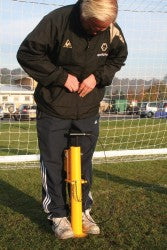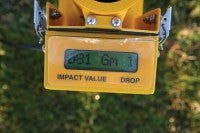Hammer Time!
 The Clegg Impact Soil Tester (commonly referred to as a clegg hammer) is a sophisticated, but simple to use, means for measuring and controlling soil strength and consolidation levels during pitch maintenance. It is also used to confirm uniform compaction over wide areas of ground, identifying poorly compacted areas and ineffective rolling of materials.
The Clegg Impact Soil Tester (commonly referred to as a clegg hammer) is a sophisticated, but simple to use, means for measuring and controlling soil strength and consolidation levels during pitch maintenance. It is also used to confirm uniform compaction over wide areas of ground, identifying poorly compacted areas and ineffective rolling of materials.
There are four sizes available. These include 0.5kg and 2.25kg types suitable for sportsturfs, with an optional special golf course tester for fairways. The larger 10kg and 20kg testers are used for testing harder materials and roadworks.
The tool consists of a compaction hammer operating within a vertical guide tube. When the hammer is released from a fixed height it falls through the tube and strikes the surface under test, decelerating at a rate determined by the stiffness of the material within the region of impact. A precision accelerometer mounted on the hammer feeds its output to a hand held digital readout unit which registers the deceleration in units of Impact Value.
It provides a compact and reliable instrument for monitoring and controlling the quality of reinstatements while the work is in progress, avoiding the need for re-excavation if later tests were to indicate poor workmanship.
In order to obtain a reliable reading of impact value it is necessary to carry out five test drops at each location. The following procedure should be followed, regardless of the material being tested:
1. Choose a test position where the guide tube can stand upright without assistance. If necessary remove excessive loose surface material (scuffing with the side of the shoe or boot is usually adequate) and ensure that the tube is not standing over a stone larger than any other stones visible at the surface.
2. Check that the guide tube is reasonably vertical and steady. Remove the locking pin that retains the hammer inside the tube and unclip the meter unit. Press the button on the readout and check the display shows zero IV (impact value).
3. Raise the hammer with one hand until the white indicator ring is level with the top of the guide tube. Make sure the cable is free and will not snag as the hammer falls; then drop the hammer cleanly. Observe the meter reading.
4. Without moving the guide tube or releasing the readout button, repeat the procedure for a further four drops to give a total of five readings at the test position.
5. Assess the set of five readings. The first two or three drops effectively take up the surface irregularities and loose material immediately beneath the hammer. The readings thereafter should get progressively higher. The third, fourth and fifth readings should level out and register the stiffness of the compacted layer under test.
 The fourth reading is the critical reading; it represents the degree of compaction being measured.
The fourth reading is the critical reading; it represents the degree of compaction being measured.
If any of the readings is more than 2 IV lower than a previous reading, or if the fifth reading is greater than the fourth by more than 2 IV, then the measurements are generally not reliable and the test should be abandoned at that location. A repeat test should be carried out around 300mm away from the position of the abandoned test location.
The clegg hammer is now widely used in sport, particularly at the top end. It is used at Wimbledon to help set up the courts, whilst the physiotherapist at Leicester City FC measures both the home and away pitches to establish if there is any correlation between the hardness of a pitch and player injuries.
The condition and hardness of a pitch will be influenced by many factors. One with little or no effective maintenance will become compacted, resulting in poor sward composition and poor drainage. The weather can also influence the condition of the pitch.
So, by using the clegg hammer it is possible to monitor pitch hardness and treat accordingly.
Clegg Hammers are available to purchase instore.
For more information ring 01902 440250
